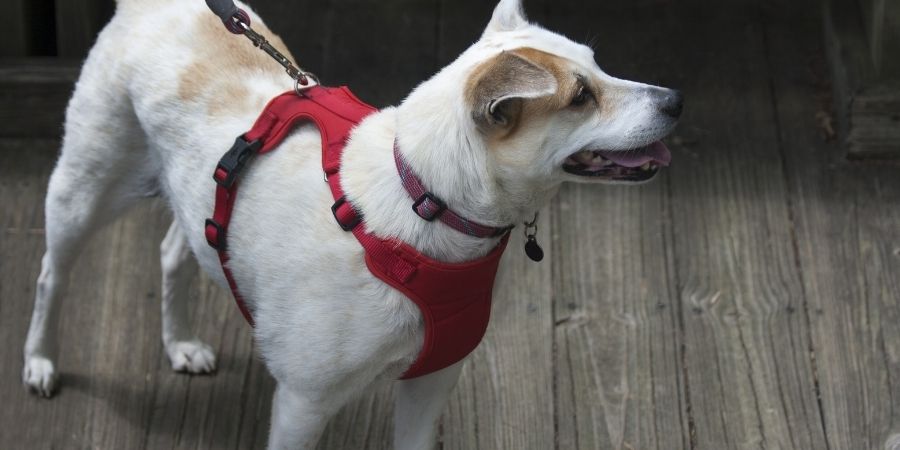Should I go running with my dog?
First and foremost, before you start running with your dog, it’s important to consider whether it’s the right way to exercise your pooch. Not all dogs are suited to running – it all depends on their general health, breed, age and personality. Here’s some things to consider to help you decide whether your dog is suited to being your running partner.

General health and breed
When considering introducing running as part of your doggy’s routine, it’s important to remember that some dogs, such as those with medical issues and breeds with flat faces, are likely to struggle when running. If this is the case, leave them at home for your run and find alternative exercises for them.
It's best to have your pooch checked by your vet before you plan to run, so they can advise you on your dog's current fitness levels, and suggest how much running they will be able to manage. They’ll also be able to check whether your dog is the ideal shape and examine for any underlying medical problems that might affect their ability to run.
Age
If you have a puppy, you should always wait until they’re fully grown before taking them out on a run. It can be harmful to your pup if they run before their little body has matured, but there’s plenty of other puppy exercises that you can try in the meantime!
Personality
When deciding whether running is right for your pooch, you’ll need to think about whether it suits their personality – even a healthy pooch can be unwilling to take a sprint!
Bear in mind that while many doggies will keep up when you run, it doesn’t always mean that they’re enjoying it. Some dogs may run with you in a state of panic, because they’re worried they’re going to get left behind!
A good way of getting to know whether your dog is likely to enjoy running, is it look at their body language when you’re out for walks or exercising off lead. If they seem stressed when you walk away, or if they’re not keen to pick up the pace when exercising, running may not be suitable for your pooch. Remember that the aim of running is for you and your dog to enjoy spending time together, so you need to make sure they’re running because they want to. If your pooch isn’t keen to run, or they prefer a more leisurely pace, it’s best to stick to other exercises such as walking or a slow paced jog to ensure it’s enjoyable for them, too.
Getting started
Once you’ve decided that running is suitable for your pooch, you’ll need to think about how much exercise your dog needs. Remember that running shouldn’t be your dog’s only exercise – you’ll need to factor in time for playtime and walkies, too. Sniffing and exploring is just as important for doggies, so make sure that your dog is still getting a chance to explore the world with their nose!
Where it’s safe, many doggies may prefer to be off their lead when running, as this gives them plenty of opportunities to sniff and explore at their own pace, without slowing you down. However, running off the lead isn’t suitable for all dogs and locations, so you’ll need to ensure that they have a suitable harness and lead. Some harnesses can restrict your dog’s movement, so remember to do your research before deciding on your pooch’s perfect running gear! You’ll need to make sure it fits comfortably and doesn’t rub.

Create a plan
When you taking your first running steps, it’s crucial to train slowly with a plan in place. To help you out, we’ve created a step-by-step schedule to follow. You’ll be able to take your route further as your dog gets fitter, but just remember to always work at your pooch’s pace throughout – and if your dog starts to struggle, or stops enjoying themselves, it's time to reassess your plan!
Step 1: Route planning
Carefully planning your route in advance is essential when it comes to running with your dog. You’ll need to think about how far you want to go and what kind of paths you’d like to follow – this will depend on your pooch’s breed, age, enthusiasm and current fitness level.
You can get a rough idea of how long you and your dog can comfortably run by thinking about your current walks. Try making your runs shorter than your walks to start with, and build up slowly as you both get fitter – to begin with, you could aim for a run that’s around half the length of your usual walk, so you know you can get back home comfortably.
Stay safe by avoiding roads and busy areas as much as possible – and remember to think about hills or inclines. It takes a lot more energy to go uphill so you might want to avoid steep climbs until you’re both fit enough. Wide tracks with an even surface are ideal for running as you can keep a steady place, reducing the risk of trips or injuries – but remember that these paths can be popular with other runners and cyclists, so you’ll need to keep your dog close by, or consider quieter running times.
Step 2: Prepare!
From your dog’s running gear to checking the weather, you’ll need to make sure you’re prepared for your journey with a pre-run checklist – once they’re all ticked off, you’re ready to head out!
- Check your dog’s harness: When running with your doggy, it’s really important to use a secure, safe harness that fits your dog perfectly. Make sure you try it on your dog ahead of your run to check that it fits comfortably and won’t rub. They’ll need to be able to run without the harness moving and becoming uncomfortable when out on their adventure!
- Take a water bottle and bowl: Running is hard work, so it’s important to make sure you have water for your pooch, so you can stop for a drink when they need one.
- Plan their dinner time: Exercising on a full stomach can be very uncomfortable for your dog and can cause them to be sick. It can also put some dogs more at risk of a life-threatening twisted stomach (GDV), so it’s important that you don’t exercise your dog too close to their meal time!
- Have your vet’s phone number to hand: It’s always useful to have your vet’s number saved in your phone before you go, just in case anything goes wrong while you’re running.
- Pack your bag: Don’t forget to take a small first aid kit and plenty of poop bags on any excursion with your pooch!
- Check the weather: Always check the weather before you set off for a run, and never attempt to run in the heat. It’s best to exercise early in the morning or late in the evening during warm weather, but you might have to avoid running altogether if it gets really hot! If your dog shows any signs that they’re struggling with the heat, stop running immediately, seek shade and offer your dog some water.
Step 3: Walk it
You’ve planned your route and your bag is packed – the next step is to walk it with your four-legged friend! Taking it slowly and building yourself up by making sure you can walk your route first, is really important – and don’t forget to take breaks if either of you gets tired!
Once you’re both able to comfortably walk your chosen route without stopping, you’re ready for the next step.
Step 4: Jog it
Once you can comfortably walk your route, you’re ready to build your speed! It’s best to do this slowly by walking for five minutes, then jogging for two, walking for five minutes and so on. Once your dog gets used to jogging, you can start to reduce the time you are walking – keep doing this until you can both comfortably jog the full route.
Step 5: The big run!
So you’ve walked and jogged, now it’s time to run! Just like jogging, it’s important to build up slowly. As before, start by repeatedly running for a few minutes, followed by jogging for a few minutes, slowly increasing the time that you are running, until you’re both able to run the whole route. Don’t forget to keep an eye on your four-legged friend to make sure they’re not getting too tired!
Once you’ve achieved this, you and your four-legged friend can officially count yourselves as runners! Now you know the distance you are both able to manage, you can start to vary your route and prepare for new running new adventures!
Read our vets’ advice about introducing agility activities to your four-legged friend.
